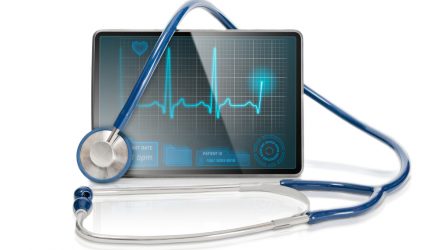Technology is widely known for innovation, but investors shouldn’t sleep on the innovative characteristics of healthcare.
In its own right, healthcare is one of the most innovative sectors and arguably the one of the most adept at leveraging disruptive technology. However, not all exchange traded funds are adequately tethered to that theme. The Goldman Sachs Future Health Care Equity ETF (GDOC) is an example of an ETF that puts investors at the epicenter of the growing healthcare/tech marriage.
As an actively managed ETF, GDOC can react nimbly to emerging trends in healthcare. That’s something many index-based rivals can’t credibly do. Take the case of robotic surgery. Granted, hospitals and surgeons have been deploying robotic surgery for a while now, but it’s a growing, evolving field, underscoring long-term potential with GDOC.
In fact, surgery is a field that’s ripe for disruption. As Goldman Sachs Asset Management (GSAM) notes, surgery is more than two centuries old, but recent tech advancements are propelling robotic surgery, improving patient outcomes along the way.
“Robotic surgery is a type of minimally invasive procedure that can help to mitigate many avoidable risks in addition to creating a better patient experience both during and after surgery for patients. Robotic surgery has implications for the entire health care industry and presents a unique opportunity for investors interested in disruptive health care technologies,” according to GSAM.
Of course, even with robotics, surgery is far from a risk-free endeavor. However, technology, including products and services offered by some GDOC member firms, can reduce that risk. That’s relevant to both surgeons and patients.
“Robotic surgery systems also afford benefits for surgeons. The robot has a greater range of motion and dexterity than a surgeon would during a minimally invasive procedure,” added GSAM. “This enables doctors to have better access to affected areas that may be in harder to reach areas of the human body versus traditional surgery. Another incredibly useful feature is live video feed from the camera being displayed on a high resolution screen. This allows the team of healthcare professionals in the room to have the best view of the procedure being carried out.”
Adding to the allure of GDOC is the sheer number of surgeries improved by robotics, including general, head and neck, heart and thoracic procedures. Millions of people undergo those surgeries every year, highlighting ample growth outlets for GDOC holdings.
“Analysts expect the number of robotic surgeries to triple by 2030, increasing from 2% worldwide to 15%. Analysts also suggest that the TAM will grow to $16B by 2030, driven by new entrants and advancements in technology,” concluded GSAM.
For more news, information, and strategy, visit the Future ETFs Channel.
The opinions and forecasts expressed herein are solely those of Tom Lydon, and may not actually come to pass. Information on this site should not be used or construed as an offer to sell, a solicitation of an offer to buy, or a recommendation for any product.

